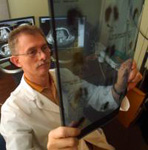Faster, safer formula to prescribe blood thinners developed

Washington, Sept 3 : Researchers have developed an improved dosing formula that can make the process of prescribing blood thinners faster and safer.
The formula called anticoagulant warfarin has been developed for doctors to estimate the appropriate dose for patients.
The formula was the joint effort of boffins from at Washington University School of Medicine in St. Louis, Saint Louis University and St. Louis College of Pharmacy.
Doctors had to go through a lengthy trial and error method before prescribing blood thinner. Now however, the improved formula of warfarin enables them to take into account variations in two key genes, which further helps in deciding the optimal dose for the patients.
The new formula is extremely challenging to use because of a number of factors that affect its activity, yet it acts as a rapid process of estimating the correct dose for patients.
Washington University investigator Brian F. Gage, M.D., medical director of Barnes-Jewish Hospitals Blood Thinner Clinic, and colleagues report their findings in the Sept. 1 issue of the journal Blood.
Their report follows closely upon the U.S. Food and Drug Administrations August 16, 2007 announcement of updated labelling for warfarin that includes information on the role of the two genes. At the time of the announcement, the director of the FDAs Office of Clinical Pharmacology, Larry Lesko, Ph.D., called for studies to establish proper dosing for patients with specific variations of these genes. The current study is the first to address that goal.
"We already knew these genes affected warfarin dosing, but we didnt know how to use that information clinically. But with this study, weve established a simple way to combine these genetic factors with clinical factors in a dosing algorithm," says Gage, also associate professor of medicine at the School of Medicine.
The researchers have made the new algorithm publicly available at www.warfarindosing.org. The Web site allows physicians to input patient information and receive dosing recommendations.
Doctors prescribe warfarin to prevent blood clots or reduce the risk of stroke in patients with atrial fibrillation, artificial heart valves, deep venous thrombosis and pulmonary emboli. It is also helpful in preventing blood clot formation after certain orthopedic surgeries such as knee or hip replacements.
Until now, doctors have had to use trial and error, repeatedly changing the dose and retesting clotting time to arrive at the warfarin dose that works for each patient. During this adjustment period, which may be a matter of two to three weeks, patients are in danger of haemorrhaging when the dose is too high or blood clots and strokes when the dose is too low.
The new formula developed by Gage and colleagues calculates the proper warfarin dose using some physical and health attributes but also factors in individual variation in the two genes VKORC1 and CYP2C9. Past research showed that certain variations in these genes can affect a persons sensitivity or resistance to warfarin and how fast a persons body breaks down the drug.
The new dosing calculation better predicts each patients response to warfarin and significantly cuts the number of dosage changes, shortening the time needed to achieve a therapeutic dose and potentially increasing patient safety.
Gage and colleagues also adapted their approach to accommodate real-world delays in gene testing, which may take two or three days to complete. Using the new method, physicians and pharmacists can use the Web tool to estimate an initial dose based on clinical factors and once the gene tests are available, revise the initial estimate to accommodate the influence of the genetic factors.
"That approach makes our method practical," Gage says.
"Physicians dont have to delay initiation of therapy while they wait for genotype results."
The dosing algorithm was established in a study of patients undergoing knee or hip replacement surgery, and Gage and colleagues are now testing it on patients with other conditions to confirm its general applicability. (With Inputs from ANI)